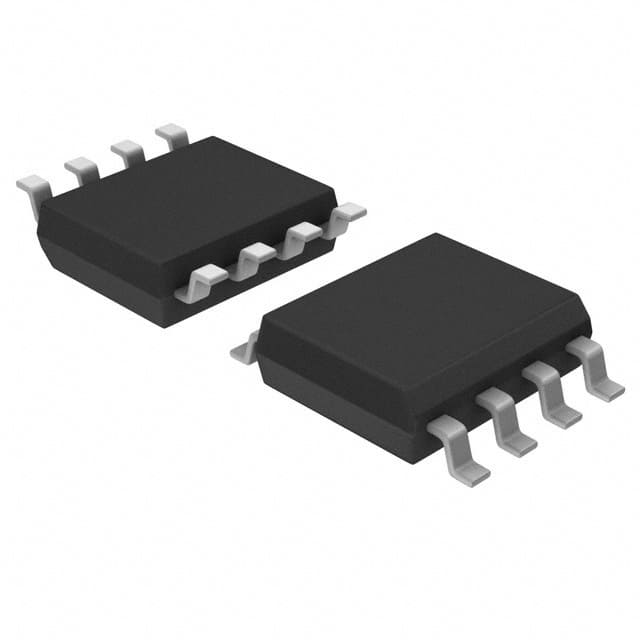Consulte las especificaciones para obtener detalles del producto.

SN74LVC2G157DCTRG4
Product Overview
- Category: Integrated Circuit (IC)
- Use: Logic Multiplexer/Demultiplexer
- Characteristics: Low-Voltage CMOS, 2-Channel, 1-of-4 Multiplexer/Demultiplexer
- Package: 8-Pin VSSOP
- Essence: This IC is designed to perform logic multiplexing and demultiplexing functions in low-voltage applications.
- Packaging/Quantity: Available in reels of 2500 units.
Specifications
- Supply Voltage Range: 1.65V to 5.5V
- High-Level Input Voltage: 0.7 x VCC
- Low-Level Input Voltage: 0.3 x VCC
- High-Level Output Voltage: 0.9 x VCC
- Low-Level Output Voltage: 0.1 x VCC
- Maximum Operating Frequency: 100 MHz
- Propagation Delay: 6 ns (max)
- Operating Temperature Range: -40°C to +85°C
Detailed Pin Configuration
The SN74LVC2G157DCTRG4 has the following pin configuration:
___________
| |
1 -|A1 VCC|- 8
2 -|B1 B2|- 7
3 -|A2 Y |- 6
4 -|GND OE |- 5
|___________|
Functional Features
- Logic Multiplexing: The IC can select one of four input signals (A1, A2, B1, B2) and route it to the output pin (Y) based on the control signal (OE).
- Logic Demultiplexing: It can also take a single input signal and distribute it to one of the four output pins based on the control signal.
- Low-Voltage Operation: The IC operates at a low voltage range of 1.65V to 5.5V, making it suitable for battery-powered devices and other low-power applications.
- High-Speed Performance: With a maximum operating frequency of 100 MHz and a propagation delay of only 6 ns, this IC ensures efficient data transmission.
Advantages
- Compact Package: The 8-pin VSSOP package allows for space-saving integration into small electronic devices.
- Wide Operating Voltage Range: The IC can operate within a broad voltage range, providing flexibility in various applications.
- Low Power Consumption: The low-voltage CMOS design minimizes power consumption, making it ideal for energy-efficient systems.
- Fast Data Transmission: The high-speed performance enables quick and reliable data transfer.
Disadvantages
- Limited Input/Output Channels: The IC supports only two input channels and four output channels, which may not be sufficient for complex multiplexing/demultiplexing requirements.
- Temperature Limitations: The operating temperature range of -40°C to +85°C may restrict its use in extreme temperature environments.
Working Principles
The SN74LVC2G157DCTRG4 operates based on the principles of digital logic. It utilizes multiplexing and demultiplexing techniques to route signals between multiple inputs and outputs. The control signal (OE) determines whether the IC functions as a multiplexer or a demultiplexer. When enabled, the IC selects one of the input signals and routes it to the output pin. Conversely, when disabled, the IC distributes a single input signal to one of the output pins.
Detailed Application Field Plans
The SN74LVC2G157DCTRG4 finds applications in various fields, including:
- Consumer Electronics: Used in portable devices, such as smartphones and tablets, for signal routing and selection.
- Automotive: Employed in automotive electronics for multiplexing/demultiplexing signals in control systems.
- Industrial Automation: Integrated into industrial control systems to manage data transmission between sensors and actuators.
- Communication Systems: Utilized in networking equipment and communication devices for signal routing and switching.
Detailed and Complete Alternative Models
- SN74LVC2G157DCTR: Similar to SN74LVC2G157DCTRG4 but without the reel packaging option.
- SN74LVC2G157DCUR: Offers the same functionality but comes in a different package (8-pin USON).
- SN74LVC2G157DCKR: Another alternative with a different package (8-pin SC70).
Note: These alternative models have similar specifications and pin configurations, providing flexibility in choosing the most suitable option for specific applications.
Word count: 552 words
Enumere 10 preguntas y respuestas comunes relacionadas con la aplicación de SN74LVC2G157DCTRG4 en soluciones técnicas
Sure! Here are 10 common questions and answers related to the application of SN74LVC2G157DCTRG4 in technical solutions:
Q: What is the SN74LVC2G157DCTRG4? A: The SN74LVC2G157DCTRG4 is a dual 2-input multiplexer IC (Integrated Circuit) that can be used for signal routing and selection in various electronic applications.
Q: What is the operating voltage range of SN74LVC2G157DCTRG4? A: The operating voltage range of SN74LVC2G157DCTRG4 is from 1.65V to 5.5V, making it compatible with a wide range of digital systems.
Q: How many inputs does SN74LVC2G157DCTRG4 have? A: SN74LVC2G157DCTRG4 has two independent data inputs, allowing you to select between them using control signals.
Q: What is the output configuration of SN74LVC2G157DCTRG4? A: SN74LVC2G157DCTRG4 has one output that can drive standard CMOS or LVTTL logic levels.
Q: Can SN74LVC2G157DCTRG4 handle high-speed signals? A: Yes, SN74LVC2G157DCTRG4 is designed to handle high-speed signals with a maximum propagation delay of 3.8 ns.
Q: Is SN74LVC2G157DCTRG4 suitable for battery-powered applications? A: Yes, SN74LVC2G157DCTRG4 has a low power consumption and can operate efficiently in battery-powered applications.
Q: What is the package type of SN74LVC2G157DCTRG4? A: SN74LVC2G157DCTRG4 comes in a small SOT-23-6 package, which is compact and suitable for space-constrained designs.
Q: Can SN74LVC2G157DCTRG4 be used in automotive applications? A: Yes, SN74LVC2G157DCTRG4 is qualified for automotive applications and meets the necessary standards for reliability and performance.
Q: Does SN74LVC2G157DCTRG4 have any built-in protection features? A: Yes, SN74LVC2G157DCTRG4 has built-in ESD (Electrostatic Discharge) protection, ensuring robustness against electrostatic events.
Q: Where can I find more information about the application of SN74LVC2G157DCTRG4? A: You can refer to the datasheet provided by the manufacturer or visit their official website for detailed application notes and design resources.
Please note that the answers provided here are general and may vary depending on specific requirements and use cases. It's always recommended to consult the datasheet and relevant technical documentation for accurate information.

